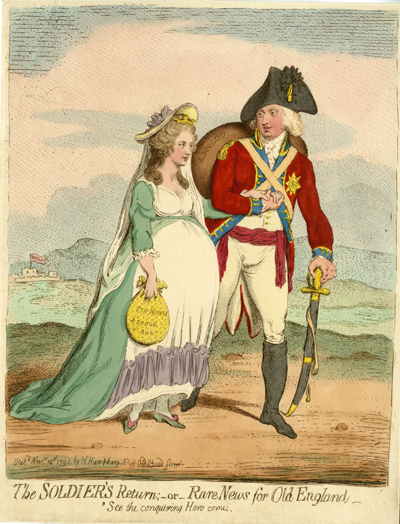The Soldier's Return. . .
This print shows Prince Frederick, Duke of York, returning from Berlin with a new bride, a potential heir apparent, and bags of money.

© Trustees of the British Museum
As the second son of King George and Queen Charlotte, the Prince had been early designed for a career on the army. He studied in Hanover and Gottingen, where, in addition to French and German, he learned Prussian military tactics, organization, and strategy. During visits to Berlin, he made the acquaintance of his cousin Frederica Charlotte, the eldest daughter of the Prussian King, and an arrangement for them to be married was made in January 1791.
The marriage, which took place in Berlin in September 1791, was more than welcome in England. Where matrimony was concerned, the family of King George and Queen Charlotte was notoriously dysfunctional. The Prince of Wales was secretly and illegally married to the Catholic widow, Mrs. Fitzherbert. The Duke of Clarence was cohabiting with his latest mistress, the actress Dorothea Jordan. And Prince Edward, the Duke of Kent had left for Canada with his most recent flame, Madame de Saint-Laurent. So it was a matter of celebration, even apart from whatever dowry she brought with her, when Frederick brought home a legitimate bride, one whom his family could actually approve.
But in addition to that rare and welcome news were initial reports that the bride came with a dowry of 300,000 pounds, pin money of 50,000 per annum and a further sum to pay off some of Frederick's gambling debts. Such a windfall more than justified the mock heroic subtitle ("See the conquering Hero comes") which Gillray borrowed from Handel's Oratorio Judas Maccabaeus. He no doubt knew that the Oratorio had been composed as a tribute to Prince William Augustus, Duke of Cumberland upon his return from a rather more substantial victory at the Battle of Culloden.
But, alas, the initial reports proved quite wrong. On November 21st, a week after The Soldier's Return appeared, the Evening Mail reported that "the Duchess of York's fortune to the Duke was only ...about 13,000 pounds sterling which was a bequest made to her by her grandfather, the old King of Prussia." So much for that part of the conquest!
But Gillray's print features an additional piece of fantasy. With the other sons of George and Charlotte unlikely to produce legitimate offspring, the Duke and Duchess of York were expected to provide some hope for a future succession. And so although impossibly early, the new Duchess of York perhaps recalling the soldier's wife in Hogarth's March to Finchley is shown very pregnant, But that wish too remained unfulfilled. The marriage fizzled after about three years. The Duchess continued childless and retired to a separate household at Oatlands Park where she devoted herself to a veritable menagerie of dogs, monkeys, and other animals.
Sources and Reading
- Commentary from the British Museum on The Soldier's Return. . .
- "Judas Maccabaeus (Handel)," Wikipedia
- "Prince Frederick, Duke of York and Albany," Wikipedia
- "Princess Frederica Charlotte of Prussia," Wikipedia
- Thomas Wright and R.H. Evans, Historical and Descriptive Account of the Caricatures of James Gillray #60
Comments & Corrections
NOTE: Comments and/or corrections are always appreciated. To make that easier, I have included a form below that you can use. I promise never to share any of the info provided without your express permission.